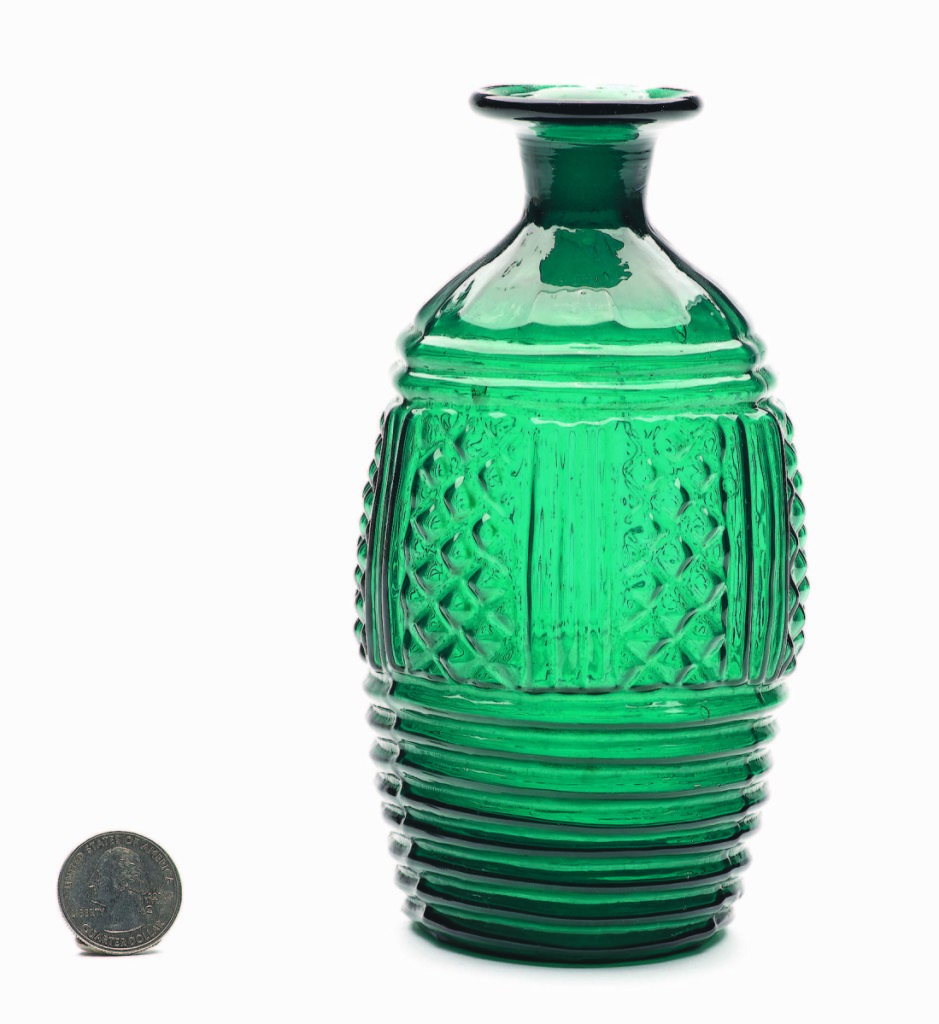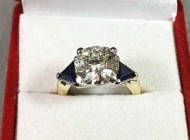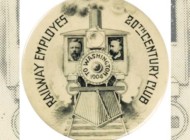Review by W.A. Demers, Photos Courtesy Norman C. Heckler
WOODSTOCK VALLEY, CONN. – Peter Tillou, a well-known figure in the art and antiques world as a premier dealer, has assembled many collections over the years, and one of his favorites is his hand-chosen free-blown and pattern molded glass. A large, third-story room in Tillou’s home was devoted to his impressive glass collection. There, a lucky visitor could see art glass in many different sizes, forms and colors. A total of 272 lots among his collection were offered by Norman C. Heckler and Company in an absentee auction that closed on September 30.
Top lot in the sale was the very first item crossing the block – a pattern molded handled Zanesville, Ohio, jug, 1820-40, ribbed and swirled to the right, with 24 ribs and an applied solid handle. Realizing $10,530 against a $3/6,000 estimate, the jug was medium orange amber with some reddish tones, had an inward rolled mouth and pontil scar. It stood 6¼ inches high with greatest diameter of 5 inches. “A rare, beautiful form in a larger than usual size,” said the firm’s Norman Heckler.
A blown three-mold decanter, probably from England, 1815-30, had a barrel form and a rich blue green color with emerald tones. With a tooled flared mouth, pontil scar and a height of 6½ inches, the piece zoomed past its $1,500 estimate to finish at $5,850.
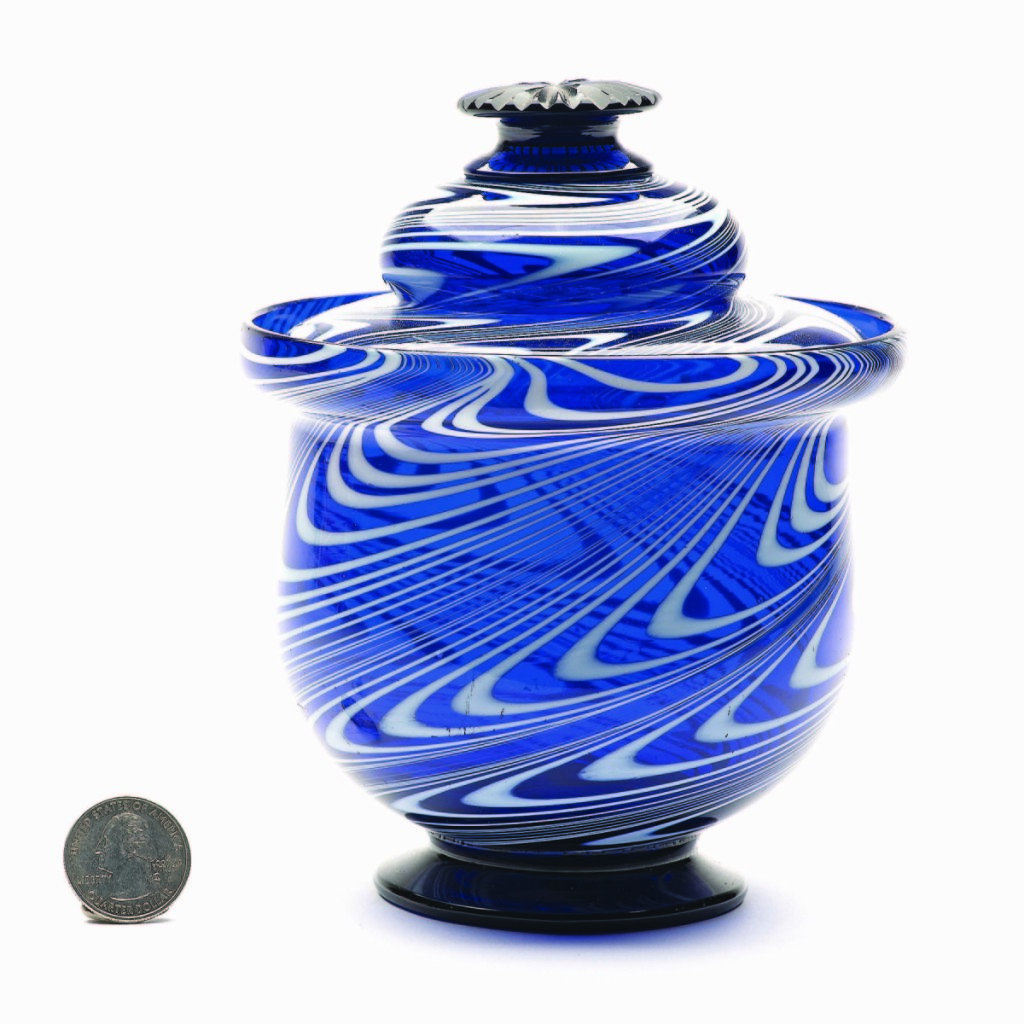
Displaying the trifecta of form, origin and color, this free-blown covered sugar bowl, probably American Midwest, 1840-60, fetched $5,558.
Sugar bowls offered in the sale were chosen by Tillou for their form, origin and color. Fetching $5,558 was a confection of a piece in the form of a free-blown covered sugar bowl, probably American Midwest, 1840-60. Its bulbous form stood on an applied solid circular foot and its free-blown cover had an applied circular cut glass knob. In cobalt blue with milk glass loopings, a tooled galleried rim and polished pontil, the sugar bowl with cover stood 6-1/8 inches high. Ending up at $1,872 was a free-blown covered sugar bowl, possibly from a South Jersey glasshouse, 1820-40. It had a bulbous form with an applied solid circular foot, domed cover with tooled rim, applied wafer and finial and exhibited a brilliant medium emerald green.
Tillou had assembled a number of pattern molded celery vases. A trumpet-form example with eight vertical ribs, probably Pittsburgh, Penn., 1840-60 was bid to an above estimate $4,973. On a hollow knop stem and applied solid circular foot, the piece exhibited rich amethyst color with applied white milk glass strings on the pillars, tooled flared rim and polished pontil scar, and it measured 10 inches in height. A piece showcasing the skills of a talented glassblower was an 8-7/8-inch high pattern molded celery vase, its eight vertical ribs tightly swirled to the right around the rim. Probably from Pittsburgh, Penn., 1830-50, and exhibiting a brilliant sapphire blue color, the cylindrical flaring vase on applied circular foot sold for $2,223.
Another probable Pittsburgh piece crossing the block was a trumpet-form free-blown vase, 1860-80, on an applied solid stem and circular foot. It was colorless, but with red, white and blue loopings, a tooled flared gauffered rim, pontil scar, and was 9 inches high. It brought $3,218.
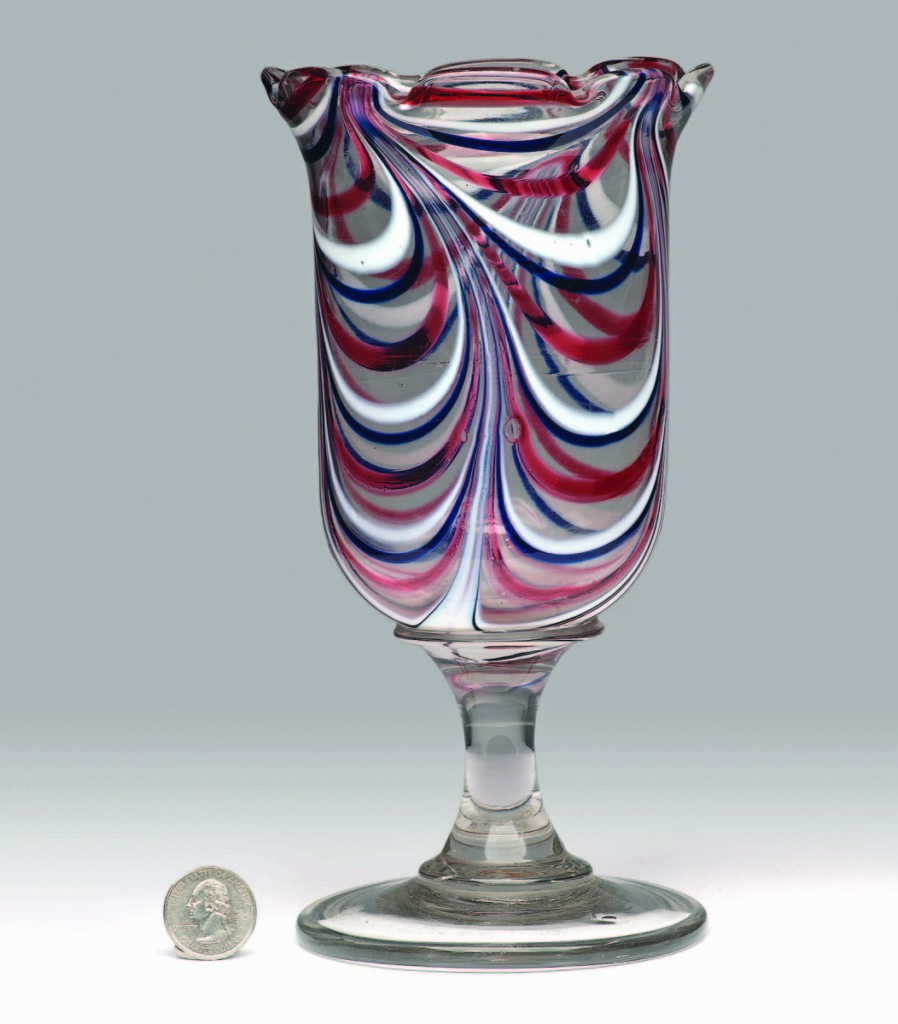
A trumpet-form free-blown vase, 1860-80, was colorless, but was alive with red, white and blue loopings. It brought $3,218.
Bringing the same amount was a beautiful piece of early American tableware with a gracefully formed handle and vivid cobalt blue color. It was a free-blown pitcher, possibly Pittsburgh, 1820-40. It had a flowerpot form, flaring to the rim with an applied hollow handle, tooled flared rim with pour spout, and it was 7-5/8 inches high. Another free-blown pitcher, possibly from a South Jersey glasshouse, 1840-60, it had a bulbous form flaring to the rim with an applied solid circular foot and solid handle. Medium amber in color and 7 inches high, it left the gallery at $1,755.
In Volume 2 of American Glass 1760-1930: The Toledo Museum of Art by Kenneth Wilson, you’ll see a blown molded back bar bottle of three-piece mold construction, probably Pittsburgh, 1840-60. Realizing $2,457, the decanter with a big, bold mold design, bulbous form with Gothic arch pattern exhibits a rich sapphire blue color with teal tones. And bringing $1,989 was a pattern molded back bar decanter, probably Pittsburgh, 1840-60. It was of inverted cone form with eight heavy vertical ribs and applied neck ring. Color was medium to deep cobalt blue, a beautiful example with bubbly glass and a wonderful exterior surface. A third back bar bottle highlight going out at $1,755 was a pressed glass example, possibly Pittsburgh, 1840-60, of cylindrical form with ten raised elongated oval panels and fluted shoulders, in a medium to deep amethyst and featuring a heavy applied double collared mouth, standing 10½ inches high.
A pattern molded pocket flask with 18 ribs swirled to the right took $2,223. From the American Midwest, 1820-40 it had a flattened chestnut form, yellowish golden amber color, sheared mouth and pontil scar. At 6¼ inches high, it was characterized as a pleasing example with bold, well defined ribs and an unusual bright color.
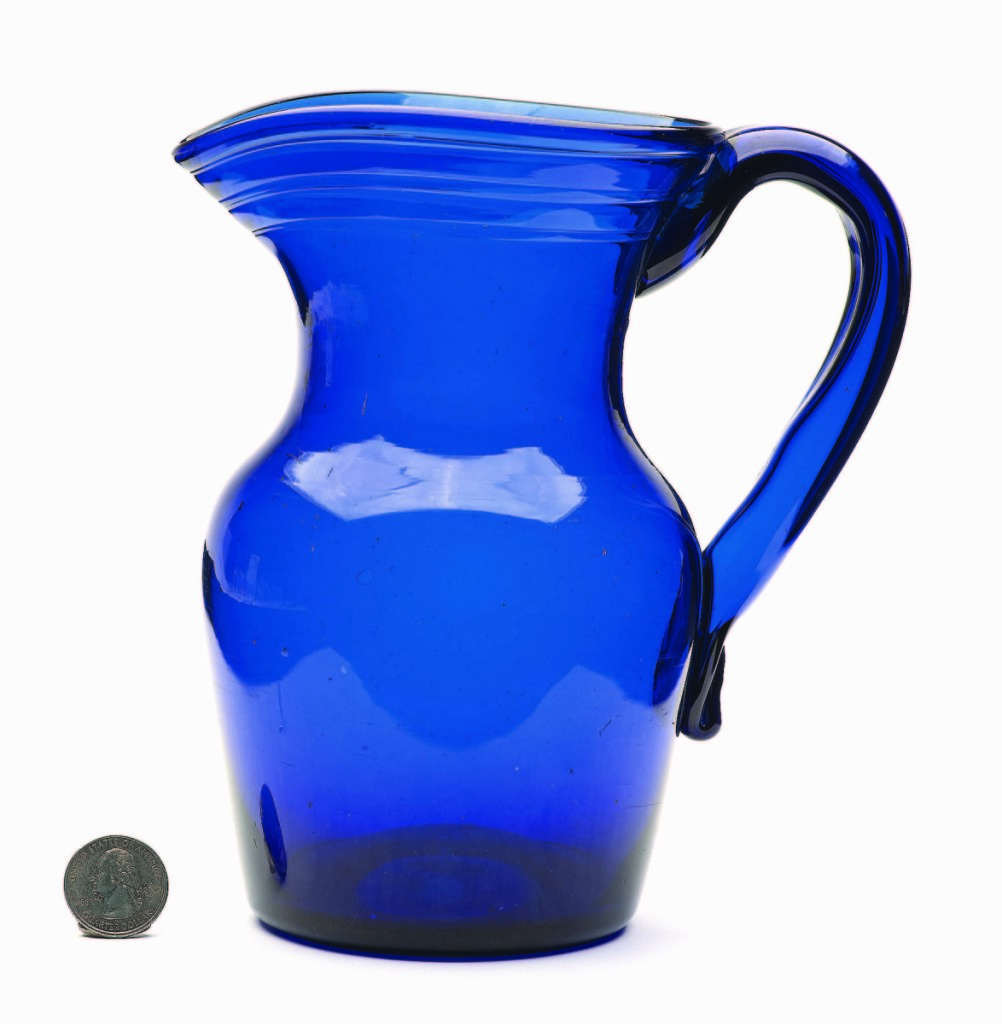
A beautiful piece of early American tableware with a gracefully formed handle and vivid cobalt blue color, this free-blown pitcher, possibly Pittsburgh, 1820-40, realized $3,218.
Mount Washington Glass Works has a long history dating back to 1837 with the South Boston, Mass., factory making exquisite, collectible glass. A pair of pressed glass fluid lamps in the arch pattern (also known as the “B.V.” pattern), three-piece construction, 1845-60, exhibited vibrant cobalt blue color and earned $1,989. Each stood 10¾ inches high.
Another exciting part of this diverse collection was the Sandwich pressed glass. Forms included vases, carafes, decanter, tumblers and more. Selling for $1,287 was a pressed glass vase with an elongated loop pattern, possibly Boston and Sandwich Glass Works, Sandwich, Mass., 1840-60. The hexagonal trumpet-form vase, standard and base, was medium emerald green with a tooled gauffered rim, 7½ inches tall.
Just as there was no shortage of color in this auction, collectors were also pleased to see Tillou’s collection of more than 30 Victorian witch balls in exciting, vibrant colors, many of which include matching stands. A free-blown example, possibly Boston and Sandwich Glass Works, Sandwich, Mass., 1840-60, was of white milk glass with blue, green, red and yellow loopings and having a 3-7/8 inch diameter. Presenting a fascinating combination of vivid colors, it conjured $1,287.
Additional highlights in the sale included a blown three-mold decanter, probably England, 1815-30, square with beveled corners and in a rich yellowish emerald green, which sold for $1,872, and, finishing $1,638, a pair of pressed glass tulip vases, Boston and Sandwich Glass Works, 1845-65, octagonal tulip form attached with wafer to an octagonal base, in a bright medium emerald green, 10 inches high and rare to be sold as a pair.
Prices given include the buyer’s premium as stated by the auction house. For information, www.hecklerauction.com or 860-974-1634.

